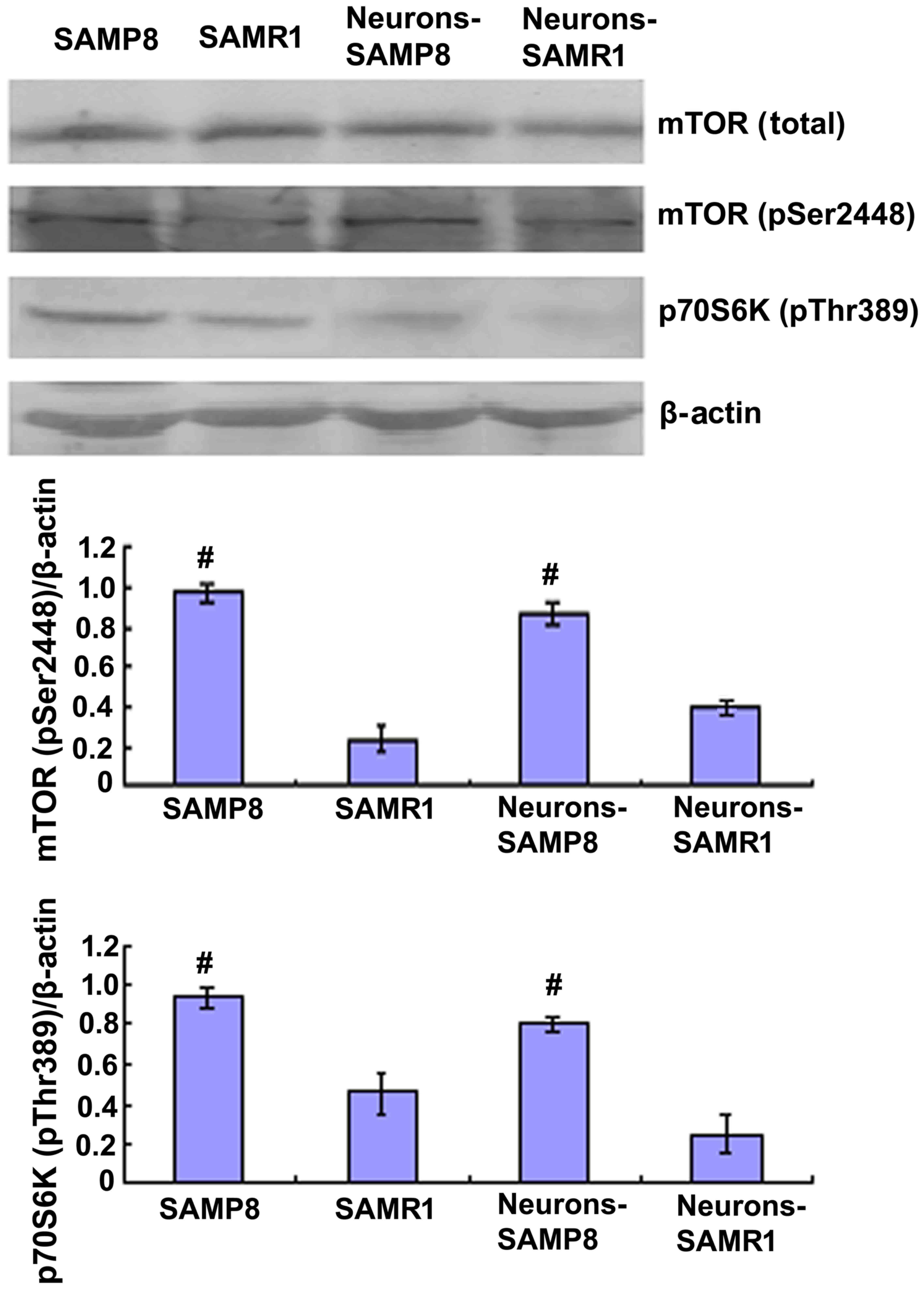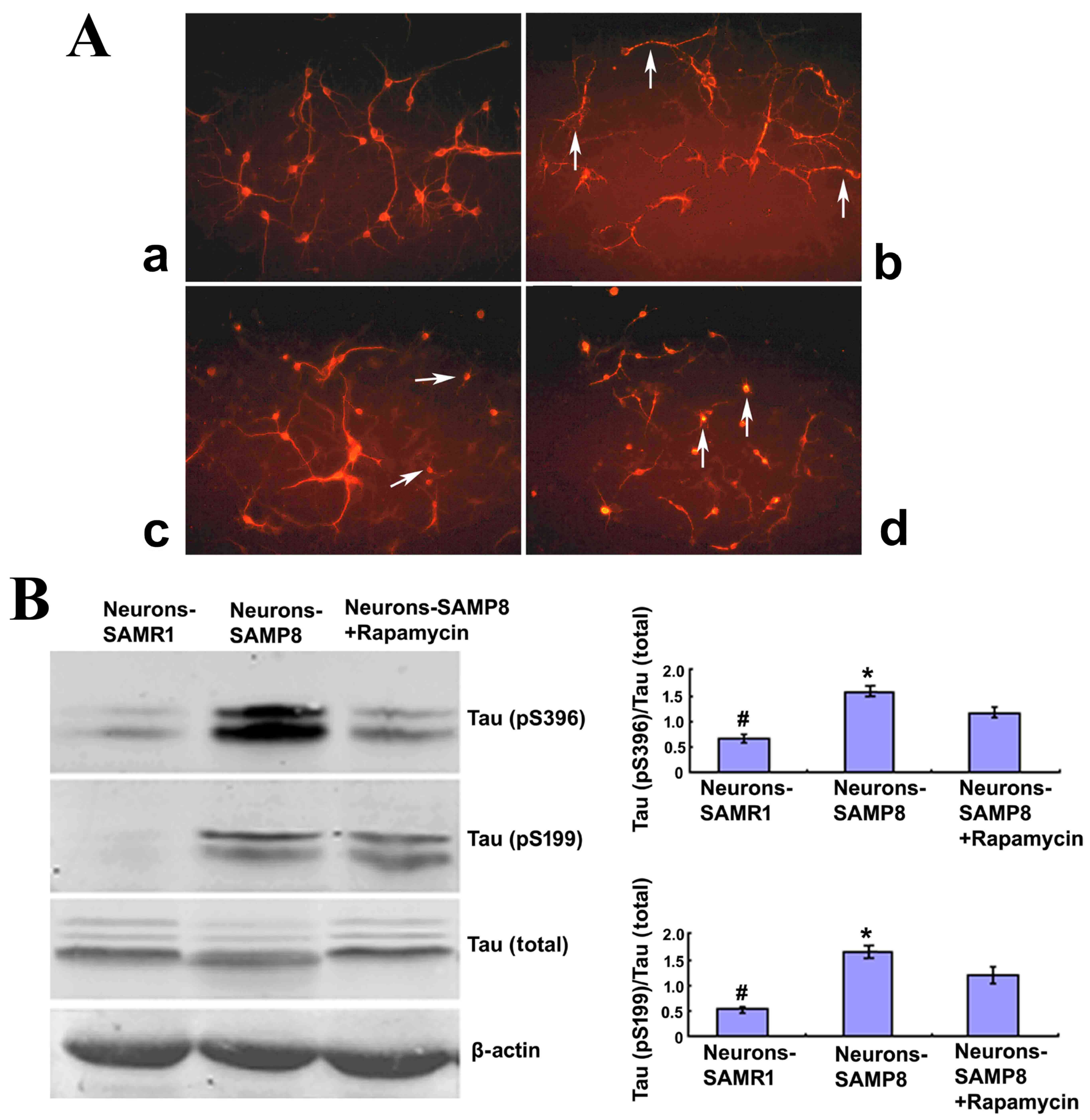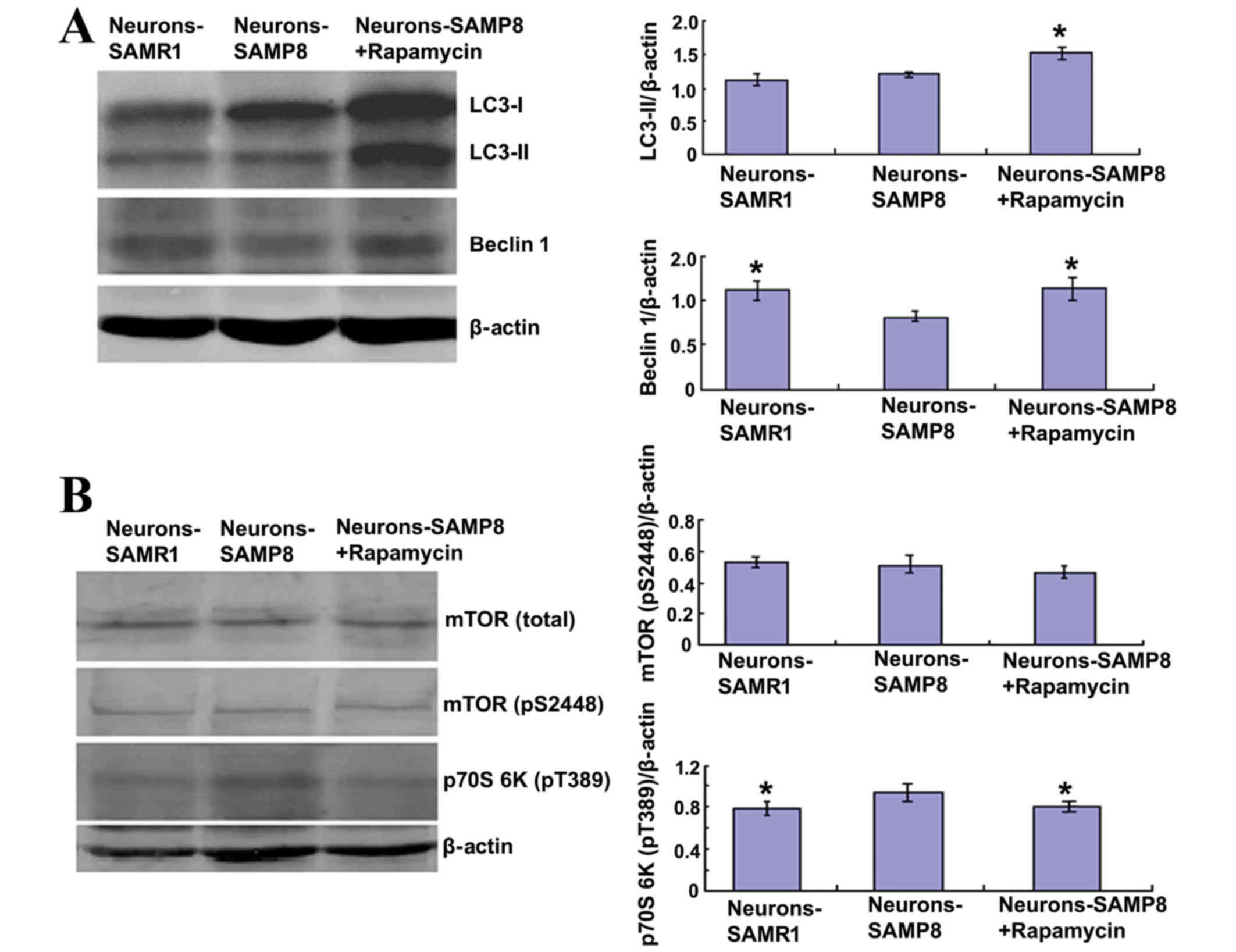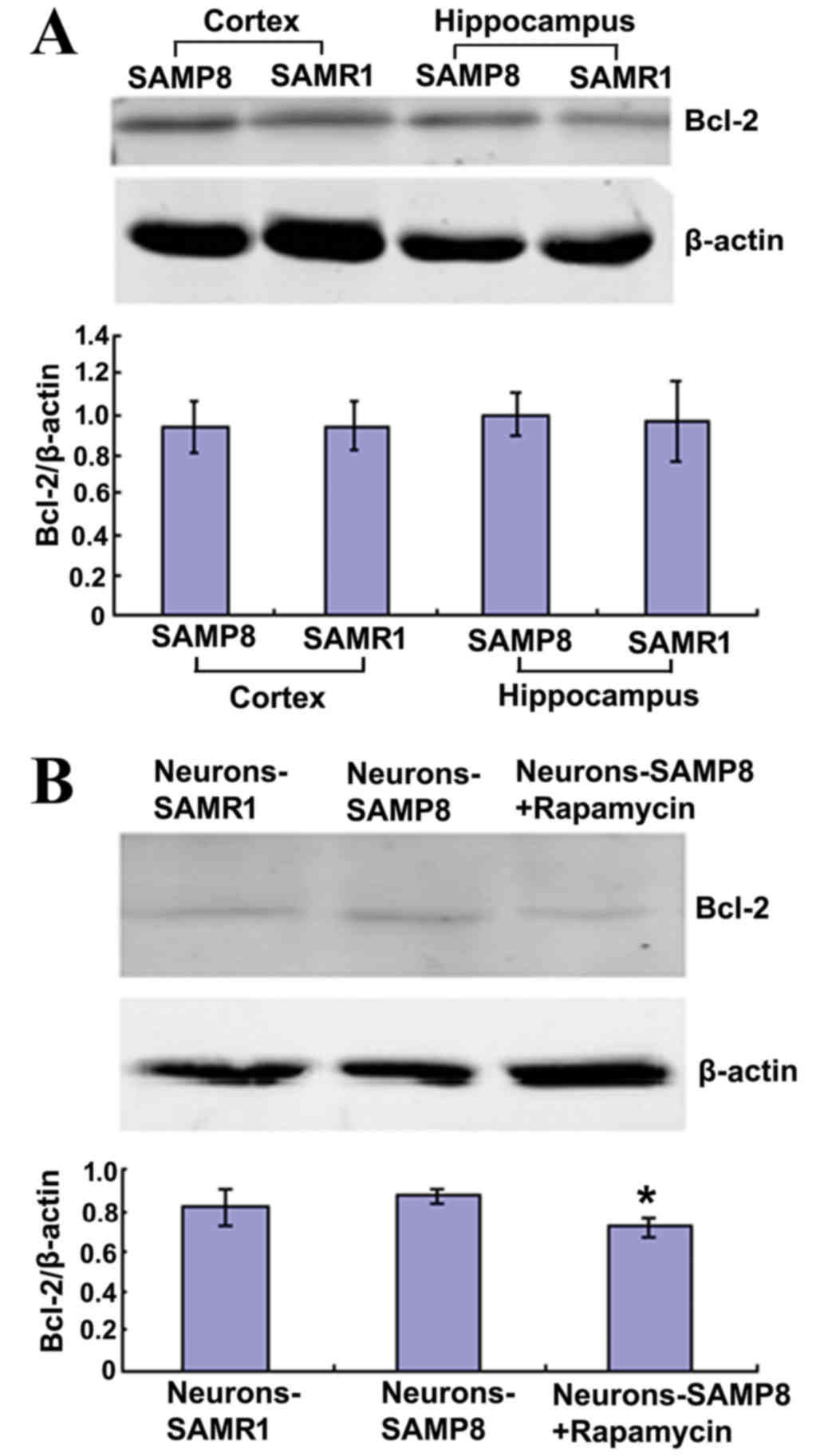|
1
|
Keith CT and Schreiber SL: PIK-related
kinases: DNA repair, recombination, and cell cycle checkpoints.
Science. 270:50–51. 1995. View Article : Google Scholar : PubMed/NCBI
|
|
2
|
Levine B and Kroemer G: Autophagy in the
pathogenesis of disease. Cell. 132:27–42. 2008. View Article : Google Scholar : PubMed/NCBI
|
|
3
|
Takei N and Nawa H: mTOR signaling and its
roles in normal and abnormal brain development. Front Mol Neurosci.
7:282014. View Article : Google Scholar : PubMed/NCBI
|
|
4
|
Meijer AJ and Codogno P: Regulation and
role of autophagy in mammalian cells. Int J Biochem Cell Biol.
36:2445–2462. 2004. View Article : Google Scholar : PubMed/NCBI
|
|
5
|
Sarkar S: Regulation of autophagy by
mTOR-dependent and mTOR-independent pathways: Autophagy dysfunction
in neurodegenerative diseases and therapeutic application of
autophagy enhancers. Biochem Soc Trans. 41:1103–1130. 2013.
View Article : Google Scholar : PubMed/NCBI
|
|
6
|
Mariño G, Madeo F and Kroemer G: Autophagy
for tissue homeostasis and neuroprotection. Curr Opin Cell Biol.
23:198–206. 2011. View Article : Google Scholar : PubMed/NCBI
|
|
7
|
Rubinsztein DC: The roles of intracellular
protein-degradation pathways in neurodegeneration. Nature.
443:780–786. 2006. View Article : Google Scholar : PubMed/NCBI
|
|
8
|
Pan T, Kondo S, Le W and Jankovic J: The
role of autophagy-lysosome pathway in neurodegeneration associated
with Parkinson's disease. Brain. 131:1969–1978. 2008. View Article : Google Scholar : PubMed/NCBI
|
|
9
|
Rivero-Ríos P, Madero-Pérez J, Fernández B
and Hilfiker S: Targeting the Autophagy/Lysosomal Degradation
Pathway in Parkinson's Disease. Curr Neuropharmacol. 14:238–249.
2016. View Article : Google Scholar : PubMed/NCBI
|
|
10
|
Wong M: Mammalian target of rapamycin
(mTOR) pathways in neurological diseases. Biomed J. 36:40–50. 2013.
View Article : Google Scholar : PubMed/NCBI
|
|
11
|
Ganley IG, Lam du H, Wang J, Ding X, Chen
S and Jiang X: ULK1.ATG13.FIP200 complex mediates mTOR signaling
and is essential for autophagy. J Biol Chem. 284:12297–12305. 2009.
View Article : Google Scholar : PubMed/NCBI
|
|
12
|
Hosokawa N, Hara T, Kaizuka T, Kishi C,
Takamura A, Miura Y, Iemura S, Natsume T, Takehana K, Yamada N, et
al: Nutrient-dependent mTORC1 association with the
ULK1-Atg13-FIP200 complex required for autophagy. Mol Biol Cell.
20:1981–1991. 2009. View Article : Google Scholar : PubMed/NCBI
|
|
13
|
Jung CH, Jun CB, Ro SH, Kim YM, Otto NM,
Cao J, Kundu M and Kim DH: ULK-Atg13-FIP200 complexes mediate mTOR
signaling to the autophagy machinery. Mol Biol Cell. 20:1992–2003.
2009. View Article : Google Scholar : PubMed/NCBI
|
|
14
|
Chen J, Zheng XF, Brown EJ and Schreiber
SL: Identification of an 11-kDa FKBP12-rapamycin-binding domain
within the 289-kDa FKBP12-rapamycin-associated protein and
characterization of a critical serine residue. Proc Natl Acad Sci
USA. 92:pp. 4947–4951. 1995; View Article : Google Scholar : PubMed/NCBI
|
|
15
|
Choi J, Chen J, Schreiber SL and Clardy J:
Structure of the FKBP12-rapamycin complex interacting with the
binding domain of human FRAP. Science. 273:239–242. 1996.
View Article : Google Scholar : PubMed/NCBI
|
|
16
|
Laplante M and Sabatini DM: mTOR signaling
in growth control and disease. Cell. 149:274–293. 2012. View Article : Google Scholar : PubMed/NCBI
|
|
17
|
King MA, Hands S, Hafiz F, Mizushima N,
Tolkovsky AM and Wyttenbach A: Rapamycin inhibits polyglutamine
aggregation independently of autophagy by reducing protein
synthesis. Mol Pharmacol. 73:1052–1063. 2008. View Article : Google Scholar : PubMed/NCBI
|
|
18
|
Tóth ML, Sigmond T, Borsos E, Barna J,
Erdélyi P, Takács-Vellai K, Orosz L, Kovács AL, Csikós G, Sass M
and Vellai T: Longevity pathways converge on autophagy genes to
regulate life span in Caenorhabditis elegans. Autophagy. 4:330–338.
2008. View Article : Google Scholar : PubMed/NCBI
|
|
19
|
Harrison DE, Strong R, Sharp ZD, Nelson
JF, Astle CM, Flurkey K, Nadon NL, Wilkinson JE, Frenkel K, Carter
CS, et al: Rapamycin fed late in life extends lifespan in
genetically heterogeneous mice. Nature. 460:392–395.
2009.PubMed/NCBI
|
|
20
|
Miller RA, Harrison DE, Astle CM, Baur JA,
Boyd AR, de Cabo R, Fernandez E, Flurkey K, Javors MA, Nelson JF,
et al: Rapamycin, but not resveratrol or simvastatin, extends life
span of genetically heterogeneous mice. J Gerontol A Biol Sci Med
Sci. 66:191–201. 2011. View Article : Google Scholar : PubMed/NCBI
|
|
21
|
Pei JJ, Björkdahl C, Zhang H, Zhou X and
Winblad B: p70 S6 kinase and tau in Alzheimer's disease. J
Alzheimers Dis. 14:385–392. 2008. View Article : Google Scholar : PubMed/NCBI
|
|
22
|
Das F, Ghosh-Choudhury N, Mahimainathan L,
Venkatesan B, Feliers D, Riley DJ, Kasinath BS and Choudhury GG:
Raptor-rictor axis in TGFbeta-induced protein synthesis. Cell
Signal. 20:409–423. 2008. View Article : Google Scholar : PubMed/NCBI
|
|
23
|
Hay N and Sonenberg N: Upstream and
downstream of mTOR. Genes Dev. 18:1926–1945. 2004. View Article : Google Scholar : PubMed/NCBI
|
|
24
|
Meske V, Albert F and Ohm TG: Coupling of
mammalian target of rapamycin with phosphoinositide 3-kinase
signaling pathway regulates protein phosphatase 2A- and glycogen
synthase kinase-3-dependent phosphorylation of Tau. J Biol Chem.
283:100–109. 2008. View Article : Google Scholar : PubMed/NCBI
|
|
25
|
Barth S, Glick D and Macleod KF:
Autophagy: Assays and artifacts. J Pathol. 221:117–124. 2010.
View Article : Google Scholar : PubMed/NCBI
|
|
26
|
Zhang W, Li Q, Song C and Lao L: Knockdown
of autophagy-related protein 6, Beclin-1, decreases cell growth,
invasion, and metastasis and has a positive effect on
chemotherapy-induced cytotoxicity in osteosarcoma cells. Tumour
Biol. 36:2531–2539. 2015. View Article : Google Scholar : PubMed/NCBI
|
|
27
|
Pattingre S, Tassa A, Qu X, Garuti R,
Liang XH, Mizushima N, Packer M, Schneider MD and Levine B: Bcl-2
antiapoptotic proteins inhibit Beclin 1-dependent autophagy. Cell.
122:927–939. 2005. View Article : Google Scholar : PubMed/NCBI
|
|
28
|
Dancey JE: Inhibitors of the mammalian
target of rapamycin. Expert Opin Investig Drugs. 14:313–328. 2005.
View Article : Google Scholar : PubMed/NCBI
|
|
29
|
An WL, Cowburn RF, Li L, Braak H,
Alafuzoff I, Iqbal K, Iqbal IG, Winblad B and Pei JJ: Up-regulation
of phosphorylated/activated p70 S6 kinase and its relationship to
neurofibrillary pathology in Alzheimer's disease. Am J Pathol.
163:591–607. 2003. View Article : Google Scholar : PubMed/NCBI
|
|
30
|
Pei JJ and Hugon J: mTOR-dependent
signalling in Alzheimer's disease. J Cell Mol Med. 12:2525–2532.
2008. View Article : Google Scholar : PubMed/NCBI
|
|
31
|
Kroemer G, Mariño G and Levine B:
Autophagy and the integrated stress response. Mol Cell. 40:280–293.
2010. View Article : Google Scholar : PubMed/NCBI
|
|
32
|
Lee JA: Neuronal autophagy: A housekeeper
or a fighter in neuronal cell survival? Exp Neurobiol. 21:1–8.
2012. View Article : Google Scholar : PubMed/NCBI
|
|
33
|
Xilouri M and Stefanis L: Autophagy in the
central nervous system: Implications for neurodegenerative
disorders. CNS Neurol Disord Drug Targets. 9:701–719. 2010.
View Article : Google Scholar : PubMed/NCBI
|
|
34
|
Mizushima N and Levine B: Autophagy in
mammalian development and differentiation. Nat Cell Biol.
12:823–830. 2010. View Article : Google Scholar : PubMed/NCBI
|
|
35
|
Ma Q, Qiang J, Gu P, Wang Y, Geng Y and
Wang M: Age-related autophagy alterations in the brain of
senescence accelerated mouse prone 8 (SAMP8) mice. Exp Gerontol.
46:533–541. 2011. View Article : Google Scholar : PubMed/NCBI
|
|
36
|
Díaz-Troya S, Pérez-Pérez ME, Florencio FJ
and Crespo JL: The role of TOR in autophagy regulation from yeast
to plants and mammals. Autophagy. 4:851–865. 2008. View Article : Google Scholar : PubMed/NCBI
|
|
37
|
Klionsky DJ, Codogno P, Cuervo AM, Deretic
V, Elazar Z, Fueyo-Margareto J, Gewirtz DA, Kroemer G, Levine B,
Mizushima N, et al: A comprehensive glossary of autophagy-related
molecules and processes. Autophagy. 6:438–448. 2010. View Article : Google Scholar : PubMed/NCBI
|
|
38
|
Klionsky DJ, Abdalla FC, Abeliovich H,
Abraham RT, Acevedo-Arozena A, Adeli K, Agholme L, Agnello M,
Agostinis P, Diwan A, et al: Guidelines for the use and
interpretation of assays for monitoring autophagy. Autophagy.
8:445–544. 2012. View Article : Google Scholar : PubMed/NCBI
|
|
39
|
Wei Y, Pattingre S, Sinha S, Bassik M and
Levine B: JNK1-mediated phosphorylation of Bcl-2 regulates
starvation-induced autophagy. Mol Cell. 30:678–688. 2008.
View Article : Google Scholar : PubMed/NCBI
|
|
40
|
Mizushima N and Yoshimori T: How to
interpret LC3 immunoblotting. Autophagy. 3:542–545. 2007.
View Article : Google Scholar : PubMed/NCBI
|
|
41
|
Menardo J, Tang Y, Ladrech S, Lenoir M,
Casas F, Michel C, Bourien J, Ruel J, Rebillard G, Maurice T, et
al: Oxidative stress, inflammation, and autophagic stress as the
key mechanisms of premature age-related hearing loss in SAMP8 mouse
Cochlea. Antioxid Redox Signal. 16:263–274. 2012. View Article : Google Scholar : PubMed/NCBI
|













